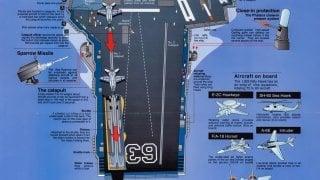Why the U.S. Navy Sells Retired Aircraft Carriers for Just 1 Cent
The decommissioning and disposal of U.S. Navy aircraft carriers have proven to be a complex and costly affair, reflected in the symbolic sale of retired carriers like the USS Kitty Hawk and USS John F. Kennedy for just one cent each.
Summary: The decommissioning and disposal of U.S. Navy aircraft carriers have proven to be a complex and costly affair, reflected in the symbolic sale of retired carriers like the USS Kitty Hawk and USS John F. Kennedy for just one cent each. The negligible sale price underscores the challenges and high costs associated with dismantling such massive vessels, which are often laden with hazardous materials like asbestos and residual chemicals.
-These factors make scrapping an expensive proposition, discouraging potential buyers and even complicating plans to preserve these historic ships as museums.
-As the Navy continues to update its fleet with newer, more advanced carriers, the financial and logistical burdens of decommissioning older ships are expected to escalate, especially with the impending retirement of nuclear-powered carriers like the USS Enterprise, which could cost upwards of a billion dollars to dismantle.
Why the U.S. Navy Sells Decommissioned Aircraft Carriers for Just a Penny
Neil Sedaka's signature song "Breaking Up is Hard to Do" was about a failed romance, but it could be the U.S. Navy's theme song when it comes to dealing with its aircraft carriers that reach their end of life. That fact explains how in 2022, the retired carriers USS Kitty Hawk (CV-63) and USS John F. Kennedy (CV-67) were sold to International Shipbreaking Limited in Texas for just one cent each!
Those shockingly weren't even the first carriers to be sold for the cost of a piece of bubblegum in the 1970s!
In 2013, the United States Navy sold the USS Forrestal (CV-59) supercarrier for a single penny to All Star Metals in Brownsville, Texas; while her sister ship USS Saratoga (CV-60) was sold for the same sum to ESCO Marine.
After efforts to save CV-59 as a museum failed to materialize, the lead vessel of the Forrestal -class was then environmentally prepared for sinking as an artificial reef. However, due to elements of the Forrestal design having led directly to current aircraft carrier design, it was intended that the ship be donated to a state and sunk to become a deep water reef, for fishery propagation and not be accessible to divers. That plan also never materialized, and the Cold War-era carrier was scrapped instead.
There were also calls by the USS Saratoga Museum Foundation to have the carrier preserved, but according to the group's final newsletter in 2010, the U.S. Navy surprised it by taking CV-60 off donation status and offering the USS John F. Kennedy as a potential museum instead. That didn't work out either.
Though the U.S. Navy has only said that it would expect the carriers to be maintained after being decommissioned, there has been speculation that these carriers also led to current designs – and it is entirely likely that the Pentagon doesn't want "tourists" gathering any secrets by strolling through the retired vessels.
So Why a Penny for an Old Aircraft Carrier?
There was a time when scrappers would have paid "good" money for retired warships. That clearly isn't the case anymore, and the "cut-price" fee reflects the reality of the situation.
Towing and ship-breaking is a costly process, and the United States Navy even paid Texas-based International Shipbreaking $3 million to rip apart the Kitty Hawk-class supercarrier USS Constellation (CV-64). Once again the sea service determined it would cost too much to turn the retired flattop into a museum, and no other nations were apparently interested in buying the Cold War-era vessel.
In other words, the U.S. Navy actually got a good deal by selling the decommissioned aircraft carrier USS Saratoga for just a penny – the lowest the sea service can offer to a company to take a flattop off the fleet's hands.
Part of the issue today is that retired warships are seen quite toxic, built at a time when the use of asbestos was common in insulation. In addition, there were many chemicals and fuels left on board that can be quite hazardous. It is costly to remove these materials, and thus fewer parties interested in handling the work.

Expect the Costs to Rise
While the U.S. Navy may have sold the last of its conventionally-powered carriers for a penny each, it will have to pay a lot to get rid of the USS Enterprise (CVN-65), the world's first nuclear-powered aircraft carrier.
In 2022, it was estimated that dismantling the carrier could take at least five years and cost between $554 and $696 million at a commercial yard. Another plan called for the dismantling to take upwards of 15 years and cost as much as $1.358 billion. The U.S. Navy is already considering plans on how to eventually dismantle its aging Nimitz-class carriers. The sea service will replace its ten Nimitz -class supercarriers on a one-for-one basis with the Gerald R. Ford -class of carriers over the next three decades.
Breaking up a carrier is hard to do, and it will be a long and expensive process.
Author Experience and Expertise: Peter Suciu
Peter Suciu is a Michigan-based writer. He has contributed to more than four dozen magazines, newspapers, and websites with over 3,200 published pieces over a twenty-year career in journalism. He regularly writes about military hardware, firearms history, cybersecurity, politics, and international affairs. Peter is also a Contributing Writer for Forbes and Clearance Jobs. You can follow him on Twitter: @PeterSuciu. You can email the author: [email protected].
Image Credit: Creative Commons.


